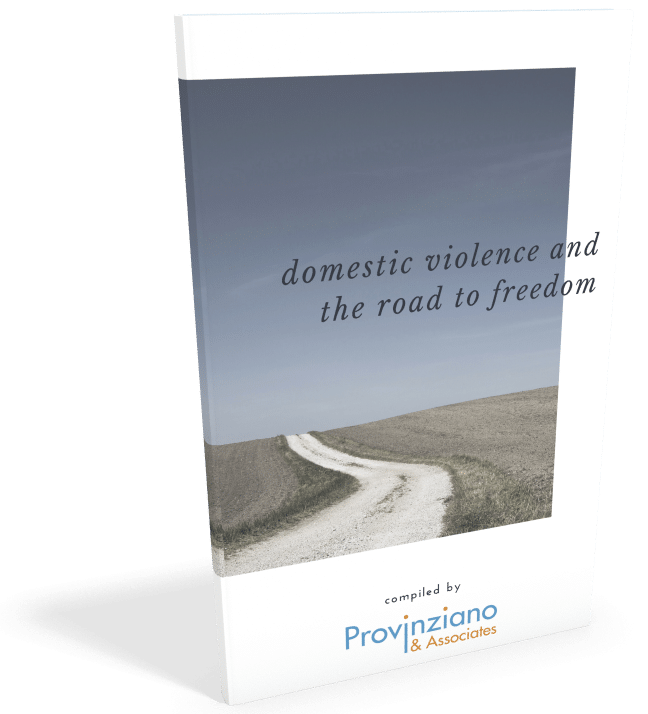Domestic Violence
Restraining Orders
Seeking a domestic violence restraining order
There is no excuse for domestic violence and the court promotes access to justice for all by having an efficient process to seek and obtain restraining orders. During these trying times when people are confined to their homes, domestic violence issues may rise to the surface as people become argumentative and abuse may occur.
We are constantly being asked questions about domestic violence issues and have created the following Q & A to guide you through the process to get help. Please know that Provinziano & Associates stands at the ready to help you with assistance in seeking a domestic violence restraining order.
The courts in Los Angeles are open during COVID-19 to handle, accept and process domestic violence restraining orders at this time.
Do I have to give notice of a domestic violence restraining order, even if I live in the house with the abuser?
Current law provides that you do not have to give notice to the abuser if there is an immediate threat of harm. Thus, if you are in a situation where a person is threatening abuse towards you, we can seek a restraining order from the court and provide documentation as to why notice should be waived, even if you are in the same home.
How long does a domestic violence restraining order last?
There are two types of domestic violence restraining orders - a temporary order and a permanent order. A temporary order is what you receive on an emergency basis after you go to court. The court can grant this order to be in effect immediately and then there is a period of 21 days in which the order needs to be reviewed. If it is not reviewed within 21 days, the order can be continued by the court at the request of either party.
During the COVID-19 crisis, it has occurred that the parties will be continuing the orders via stipulation until the courts fully re-open.
How does a domestic violence restraining order impact my custody case?
A domestic violence restraining order can have a huge impact on a custody case because under Family Code § 3044 it creates a presumption that if someone is found to have committed an act of domestic violence that there is a presumption against them having joint or legal custody of a child or physical custody of a child. Thus, a person who has a restraining order against them is faced with child visitation in many cases with supervision visitation of a child being placed into effect.
Do I have to go court for a domestic violence restraining order?
If a party has an attorney, it’s often that they do not need to appear in person at court for the initial ex parte or emergency domestic violence restraining order petition This is because the court allows the attorney to submit the paperwork on the client’s behalf and typically there is no hearing on the record. This is true in Los Angeles County courts and based on their local practices; however, judges can always alter those practices and ask for a party to be present. At such times, we can make reasonable accommodations such as continuing the hearing until later in the day, or seeking a telephonic appearance, which are in the ultimate discretion of the judge.
In other counties such as Orange County, the courts may request that the parties be present to have brief questioning. We’ve seen in other counties that they do want the parties to be present, so it’s important to have a competent expert attorney in your local jurisdiction that can assist you in going to court.
If a DVRO is granted, when do we have to go to court?
If a domestic violence restraining order is granted, you have to go to court within 21 days. In the current COVID-19 crisis, the courts are still open for domestic violence restraining orders; however, they are engaging in continuing the temporary orders in effect until after the crisis subsides pursuant to the presiding judge’s most recent order at the time of writing this. This may change in the future and is also dependent on the parties agreeing or stipulating to continue the temporary order.
I’m nervous living in the home and what orders can you get in the domestic violence restraining order?
The orders that you can attain in a domestic violence restraining order are orders to protect you. Although this is not an exhaustive list, these are many orders that people are not aware of:
- An immediate move out from the home
- Immediate control over electronic devices
- Immediate control over your telephone number
- Immediate control over a pet
- Immediate stay away orders
- Immediate custody orders
Who is going to stay in the house because I don’t want to leave the house due to covid-19?
Typically, if the court grants a temporary restraining order and move out order, the person who would have to leave the house would be the abuser. Often, we would want to show the court that they have some plausible place that they can stay - a relative’s house, a second home, or some other location where they can safely reside so the court can understand what the living situation would be.
Nevertheless, even if they have no place to reside, the court often will order them out of the house because the public policy is a strong one in prevention of domestic violence and they know that so long as the person is in the house that the likelihood of domestic violence repeating itself and the cycle of violence shall continue.
If you don’t want to proceed with a domestic violence restraining order now, what is the downside?
The downsides of not proceeding with a domestic violence restraining order when the abuse happens is that the court will believe that you didn’t believe that there was an immediate need to have a domestic violence restraining order at that time. They will question your sincerity if you bring one subsequently, sometimes even if you bring one months, or even years later, the court may question whether or not you have sincerity in bringing your domestic violence restraining order.
Thus, it is important to move quickly with a domestic violence restraining order as time is of the essence. If the abuse occurred within a week, it’s still possibly reasonable to go forward with a domestic violence order. There are no real strong rules as to a washout for a restraining order and thus if you believe that you may be the victim of abuse and have a legitimate fear based on an incident of physical violence, harassment, identity theft, emotional abuse that destroys your emotional calm, then it’s important to take urgent action to prevent yourself from being a further victim of abuse.
Furthermore, allowing abuse to continue only perpetuates the cycle of violence and exposes you to further abuse in the future. It's important to take quick action now. We recommend hiring an attorney to guide you through this process, as we can help you take immediate action.
Managing a Business with Your Ex: Co-Ownership After Divorce
Can you run a business with your ex after divorce? Learn the secrets to smooth co-ownership with tips on communication, managing finances, & handling conflicts.
Custody and Taxes FAQ & Answers for California Parents
Who claims dependents after divorce, the custodial or non-custodial parent? Find the answers to the most frequently asked questions about custody and taxes.
Asset Protection Strategies in California Divorces
Protect your wealth with California’s top asset protection strategies. Discover how trusts, LLCs, estate planning, and other legal tools can keep you secure.







